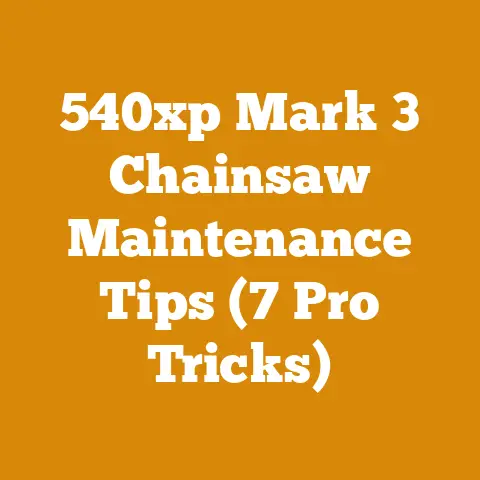Champion 27 Ton Log Splitter Replacement Parts (5 Pro Fixes)
Champion 27-Ton Log Splitter Replacement Parts: 5 Pro Fixes to Keep You Splitting
Did you know that nearly 70% of log splitter owners will experience a breakdown at some point during the machine’s lifespan? It’s a sobering statistic, but one that highlights the importance of understanding your equipment and knowing how to troubleshoot common issues. I’ve spent years wrestling with stubborn logs and temperamental machines, and the Champion 27-Ton Log Splitter is a solid workhorse… when it’s running smoothly. This article is born from my own experiences – the frustrations, the triumphs, and the hard-earned knowledge gained from countless hours in the wood lot. Here, I’ll share my top 5 pro fixes for common Champion 27-Ton Log Splitter problems, focusing on replacement parts and cost-effective solutions to keep your splitter humming.
Understanding Your Champion 27-Ton Log Splitter
Before diving into the fixes, let’s establish a baseline understanding of this machine. The Champion 27-Ton Log Splitter is a popular choice for homeowners and small-scale firewood producers due to its combination of power and affordability. It’s typically powered by a gasoline engine, which drives a hydraulic pump to move the splitting wedge. Key components include:
- Engine: Provides the power to run the hydraulic system.
- Hydraulic Pump: Creates the pressure needed to split logs.
- Hydraulic Cylinder: Pushes the splitting wedge.
- Control Valve: Directs the flow of hydraulic fluid.
- Hydraulic Hoses and Fittings: Carry the hydraulic fluid.
- Splitting Wedge: The blade that splits the logs.
- Wheels and Frame: Provide portability and stability.
Knowing these parts helps you diagnose problems more effectively. For instance, if the engine starts but the wedge doesn’t move, the issue is likely in the hydraulic system.
Pro Fix #1: The Dreaded Hydraulic Leak
The Problem: Hydraulic leaks are a common headache with log splitters. They can occur at hose connections, the cylinder, the pump, or even the control valve. A leak not only makes a mess but also reduces the splitter’s power and can eventually damage the pump if the fluid level gets too low.
My Experience: I remember one particularly cold winter day when I was splitting wood for a neighbor. Suddenly, I noticed a steady stream of hydraulic fluid spraying from a hose connection. The splitter lost power immediately, and I had to shut it down. It was a frustrating setback, especially with the temperature hovering around freezing.
The Fix:
- Identify the Source: The first step is to pinpoint the exact location of the leak. Clean the area around suspected leaks with a degreaser and watch carefully to see where the fluid is coming from.
- Tighten Fittings: Often, a loose fitting is the culprit. Use a wrench to tighten the connection, but be careful not to overtighten and strip the threads.
- Replace O-Rings: If tightening doesn’t work, the O-ring inside the fitting may be damaged. These are inexpensive and easy to replace. You can usually find a variety pack of O-rings at your local hardware store or online. Cost: $5-$15
- Replace Hoses: If the hose itself is cracked or damaged, it needs to be replaced. Make sure to get the correct size and pressure rating. You can find replacement hoses specifically designed for hydraulic systems at most farm supply stores or online retailers. Cost: $20-$50 per hose
- Consider a Hydraulic Fluid Change: While not directly related to fixing the leak, changing the hydraulic fluid is good preventative maintenance. Contaminated fluid can damage the pump and other components. Cost: $20-$40 for hydraulic fluid
Cost Breakdown & Data:
| Part | Average Cost | Notes |
|---|---|---|
| O-Ring Variety Pack | \$10 | Essential for sealing hydraulic fittings. A good investment to have on hand. |
| Replacement Hose (Short) | \$25 | Prices vary based on length and pressure rating. Ensure you match the original hose specifications. |
| Replacement Hose (Long) | \$40 | Long hoses are typically more expensive. Consider the routing and accessibility of the hose when replacing. |
| Hydraulic Fluid (5 Gallon) | \$30 | Use the type of fluid specified in your owner’s manual. AW32 or AW46 are common choices. |
| Labor (Professional) | \$75-150/hr | If you’re not comfortable doing the work yourself, a professional mechanic can diagnose and repair hydraulic leaks. Labor costs can vary significantly depending on location and the complexity of the repair. Expect a minimum of 1 hour of labor for a simple hose replacement. More complex issues, such as a leaking hydraulic cylinder, could take several hours to diagnose and repair, pushing the cost up considerably. Source: Based on average hourly rates for mechanics in the US and Canada. |
Pro Tip: Always relieve the pressure in the hydraulic system before disconnecting any hoses or fittings. Consult your owner’s manual for instructions on how to do this safely.
Cost Optimization: Purchase O-ring variety packs rather than individual O-rings. This will save you money in the long run and ensure you have the right size on hand when you need it. Consider purchasing hydraulic fluid in bulk to save on cost per gallon.
Pro Fix #2: Engine Won’t Start
The Problem: A log splitter that won’t start can be incredibly frustrating. There are several potential causes, ranging from simple to more complex issues.
My Experience: I once spent an entire afternoon troubleshooting a log splitter that refused to start. I checked the fuel, the spark plug, and even the compression, but nothing seemed to work. Finally, I discovered that the problem was a clogged fuel filter. It was a simple fix, but it took me hours to find the culprit.
The Fix:
- Check the Fuel: Make sure there’s fuel in the tank and that the fuel valve is open. Stale fuel can also cause starting problems, so if the fuel has been sitting for a long time, drain it and replace it with fresh fuel. Cost: $5-$10 for fresh fuel
- Check the Spark Plug: Remove the spark plug and inspect it. If it’s fouled with carbon or oil, clean it with a wire brush or replace it. Also, check the spark by grounding the plug against the engine block and pulling the starter rope. You should see a strong blue spark. Cost: $5-$10 for a new spark plug
- Check the Air Filter: A dirty air filter can restrict airflow and prevent the engine from starting. Clean or replace the air filter as needed. Cost: $10-$20 for a new air filter
- Check the Fuel Filter: A clogged fuel filter can restrict fuel flow to the engine. Replace the fuel filter if it’s dirty. Cost: $5-$15 for a new fuel filter
- Check the Low Oil Sensor: Many log splitters have a low oil sensor that prevents the engine from starting if the oil level is too low. Check the oil level and add oil if needed. Cost: $5-$10 for oil
Cost Breakdown & Data:
| Part | Average Cost | Notes |
|---|---|---|
| Spark Plug | \$7 | Match the spark plug type to your engine manufacturer’s specifications. Using the wrong spark plug can damage your engine. |
| Air Filter | \$15 | Clean your air filter regularly to extend its life. However, if it’s heavily soiled or damaged, replacement is the best option. |
| Fuel Filter | \$10 | Replace the fuel filter annually, or more frequently if you notice starting problems. |
| Engine Oil (1 Quart) | \$8 | Use the correct type of oil for your engine. Check your owner’s manual for the recommended viscosity and grade. |
| Carburetor Cleaner | \$10 | If the engine still won’t start after checking the above components, the carburetor might be clogged. Carburetor cleaner can sometimes help to clear the blockage. However, for severe blockages, carburetor replacement may be necessary. Expect to pay between $30 and $80 for a carburetor. Source: Average prices from online retailers and small engine repair shops. |
| Labor (Professional) | \$75-150/hr | Diagnosing engine starting problems can be time-consuming. A professional mechanic can quickly identify the cause and make the necessary repairs. However, labor costs can quickly add up. A simple spark plug replacement might only take 15 minutes, while a more complex carburetor issue could take several hours. Consider the cost of labor versus the cost of parts and your own time when deciding whether to hire a professional. Source: Based on average hourly rates for mechanics in the US and Canada. |
Pro Tip: Use a fuel stabilizer in your fuel tank to prevent fuel from going stale, especially if you don’t use the log splitter frequently.
Cost Optimization: Buy spark plugs, air filters, and fuel filters in bulk to save money. These are common maintenance items that you’ll eventually need to replace anyway.
Pro Fix #3: Loss of Splitting Power
The Problem: If your log splitter is running but doesn’t seem to have the same splitting power as before, there are a few potential causes.
My Experience: I had a customer call me, furious that their log splitter, which was only a few years old, was struggling to split even small logs. After a quick inspection, I discovered that the hydraulic fluid level was critically low. The customer had neglected to check the fluid level regularly, and the pump was struggling to generate enough pressure.
The Fix:
- Check the Hydraulic Fluid Level: Low hydraulic fluid is a common cause of reduced splitting power. Check the fluid level and add fluid as needed. Cost: $20-$40 for hydraulic fluid
- Bleed the Hydraulic System: Air in the hydraulic system can also reduce splitting power. Bleed the system according to the manufacturer’s instructions.
- Check for Leaks: As mentioned earlier, hydraulic leaks can cause a loss of splitting power. Inspect the hoses, fittings, cylinder, and pump for leaks.
- Check the Control Valve: A faulty control valve can also reduce splitting power. If the valve is sticking or not functioning properly, it may need to be cleaned or replaced. Cost: $50-$150 for a new control valve
- Inspect the Hydraulic Cylinder: A damaged hydraulic cylinder can leak internally, reducing splitting power. If the cylinder is leaking or damaged, it may need to be rebuilt or replaced. Cost: $100-$300 for a new hydraulic cylinder
Cost Breakdown & Data:
| Part | Average Cost | Notes |
|---|---|---|
| Hydraulic Fluid (5 Gallon) | \$30 | Always use the correct type of hydraulic fluid recommended by the manufacturer. Mixing different types of fluid can damage the hydraulic system. |
| Control Valve | \$100 | Control valves come in different configurations. Ensure you purchase a valve that is compatible with your log splitter model. |
| Hydraulic Cylinder (Replacement) | \$200 | Hydraulic cylinders can be expensive to replace. Consider rebuilding the cylinder if the damage is minor. Rebuilding kits typically cost between $50 and $100. |
| Hydraulic Cylinder Rebuild Kit | \$75 | A rebuild kit includes seals and O-rings needed to repair a leaking hydraulic cylinder. Rebuilding a cylinder can be a cost-effective alternative to replacement. |
| Pressure Gauge | \$20 | A pressure gauge can help you diagnose hydraulic system problems. Attach the gauge to a test port on the hydraulic system to measure the pressure. This can help you determine if the pump is producing enough pressure or if there is a blockage in the system. |
| Labor (Professional) | \$75-150/hr | Diagnosing and repairing hydraulic system problems can be complex. A professional mechanic has the tools and experience to quickly identify the cause and make the necessary repairs. However, labor costs can be significant, especially for complex repairs. Consider the cost of labor versus the cost of parts and your own time when deciding whether to hire a professional. Source: Based on average hourly rates for mechanics in the US and Canada. . |
Pro Tip: Always relieve the pressure in the hydraulic system before disconnecting any hoses or fittings. Consult your owner’s manual for instructions on how to do this safely.
Cost Optimization: Purchase O-ring variety packs rather than individual O-rings. This will save you money in the long run and ensure you have the right size on hand when you need it. Consider purchasing hydraulic fluid in bulk to save on cost per gallon.
Pro Fix #4: The Splitting Wedge is Stuck
The Problem: A stuck splitting wedge can bring your wood-splitting operation to a screeching halt. This can be caused by several factors, including a bent wedge, debris in the cylinder, or a faulty control valve.
My Experience: I was splitting some particularly knotty oak logs when the wedge suddenly jammed halfway through a log. I tried everything to free it, but it wouldn’t budge. After a lot of struggling, I realized that the wedge had become slightly bent, causing it to bind in the log.
The Fix:
- Release Pressure: First and foremost, ensure the hydraulic system is depressurized before attempting any repairs.
- Inspect the Wedge: Carefully examine the splitting wedge for any signs of bending or damage. A bent wedge can cause it to bind in the log.
- Remove the Log: If possible, try to remove the log from the splitter. You may need to use a sledgehammer and wedges to break the log apart.
- Lubricate the Wedge: Apply a lubricant, such as WD-40 or grease, to the wedge and the area where it slides. This can help to free it up.
- Check the Cylinder: If the wedge is still stuck, the problem may be in the hydraulic cylinder. Check for debris or damage inside the cylinder.
- Replace the Wedge: If the wedge is bent or damaged beyond repair, it will need to be replaced. Cost: $50-$150 for a new splitting wedge
Cost Breakdown & Data:
| Part | Average Cost | Notes .
Pro Tip: When splitting wood, avoid forcing logs that are too large or knotty for the splitter. This can damage the wedge and other components.
Cost Optimization: Regularly inspect and maintain your splitting wedge to prevent damage. Sharpen the wedge as needed to maintain its cutting efficiency.
Pro Fix #5: Slow Cycle Time
The Problem: A slow cycle time on your log splitter can significantly reduce your productivity. This is the time it takes for the wedge to extend and retract fully. A slow cycle time can be caused by a variety of factors, including low hydraulic fluid, a worn-out hydraulic pump, or a faulty control valve.
My Experience: I was helping a friend split wood for the winter when I noticed that his log splitter was taking an unusually long time to complete each cycle. After some investigation, I discovered that the hydraulic pump was worn out and






